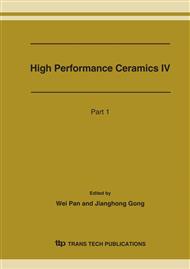p.448
p.452
p.455
p.459
p.463
p.466
p.470
p.474
p.477
Synthesis and Electrochemical Properties of a LiNi0.7Co0.3O1.9Cl0.1 Cathode Material for Lithium-Ion Battery
Abstract:
Partial oxygen in LiNi0.7Co0.3O2 was replaced by chlorine to form LiNi0.7Co0.3O1.9Cl0.1. Phase structure of LiNi0.7Co0.3O1.9Cl0.1 was identified as a pure hexagonal lattice of α-NaFeO2 type by X-ray diffraction. Discharge capacity of LiNi0.7Co0.3O1.9Cl0.1 was 202 mAh/g in initial cycle at 15 mA/g current density in 2.5- 4.3 V potential window. The constant current charge/discharge experiments and cyclic voltammograms showed that chlorine addition was effective to improve reversible capacity and cycle stability of LiNi0.7Co0.3O2.
Info:
Periodical:
Pages:
463-465
Citation:
Online since:
April 2007
Authors:
Keywords:
Price:
Сopyright:
© 2007 Trans Tech Publications Ltd. All Rights Reserved
Share:
Citation:


